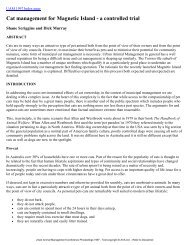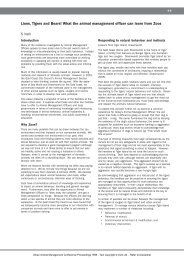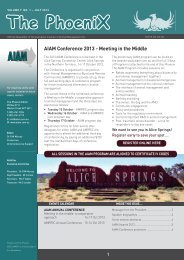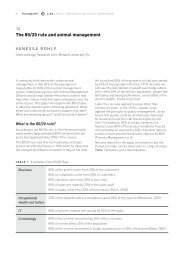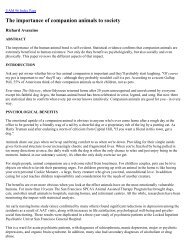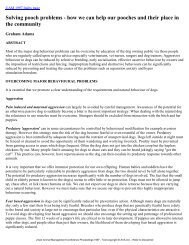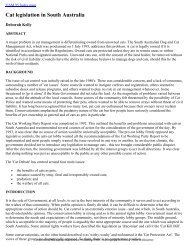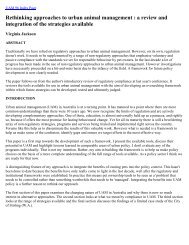Proceedings OF ThE - Australian Institute of Animal Management Inc
Proceedings OF ThE - Australian Institute of Animal Management Inc
Proceedings OF ThE - Australian Institute of Animal Management Inc
Create successful ePaper yourself
Turn your PDF publications into a flip-book with our unique Google optimized e-Paper software.
Annual Conference on <strong>Animal</strong> <strong>Management</strong> AIAM <strong>Proceedings</strong> 2012 45<br />
Discussion<br />
Latency to touch the target differed significantly<br />
between probes, showing that dogs respond<br />
differently to probes, being on average quicker<br />
to touch the target after probes that were more<br />
similar to the milk tone than those similar to the<br />
water tone. This supports the expectation that dogs<br />
respond differentially to signals and that this may<br />
correspond to their expectations <strong>of</strong> positive and<br />
negative outcomes. The dogs in this study were not<br />
subjected to any manipulations expected to alter<br />
their affective state or expectations. Therefore, no<br />
conclusions can be drawn from this study about<br />
the efficacy <strong>of</strong> cognitive bias in measuring affective<br />
state in dogs. Nonetheless, the differing responses<br />
between dogs suggests dogs are interpreting probes<br />
differently to each other, which adds support to the<br />
use <strong>of</strong> cognitive bias as a surrogate measure <strong>of</strong><br />
affect. It is also possible that the differences shown<br />
in this study between dogs and their responses to<br />
probes represents different degrees <strong>of</strong> optimism and<br />
pessimism relating to personality differences rather<br />
than differences in affect. The root cause <strong>of</strong> these<br />
differences in responses between dogs is unknown.<br />
Cognitive biases in humans are sensitive to both<br />
short-term changes in an individual’s level <strong>of</strong> anxiety<br />
(state anxiety) and long-term, individual difference<br />
in an individual’s tendency to experience anxiety<br />
(trait anxiety). There is some evidence in animals<br />
that some individuals may be inherently more<br />
pessimistic than others, for example, stereotyping<br />
starlings and macaques are more pessimistic<br />
than non-stereotyping or reduced stereotyping<br />
conspecifics (Brilot et al. 2010; Bethell et al. 2012),<br />
and dogs that show indications <strong>of</strong> separation-related<br />
distress are more pessimistic than dogs that do not<br />
(Mendl et al. 2010). It is possible, particularly with<br />
Assistance Dogs Australia dogs that are kept in the<br />
same environment, that the differences in responses<br />
between dogs represent a fundamental difference<br />
in how individual dogs cope with challenging<br />
environments, or perhaps an inherent tendency<br />
towards optimism or pessimism akin to the trait<br />
anxiety described above.<br />
Latencies differed significantly between cognitive<br />
bias tests, suggesting that some dogs at least may<br />
respond to fewer probes over time as they learn<br />
that probes are not reinforced. This effect has been<br />
documented in sheep (Doyle et al. 2010a), but despite<br />
being searched for in dogs, was not identified (Mendl<br />
et al. 2010). It is possible this effect was not found<br />
before in dogs because the method used by Mendl et<br />
al. (2010) required fewer trials (21-61 as opposed to<br />
at least 12 session <strong>of</strong> 48 trials each in this study) with<br />
fewer probes (4 vs 9 in this study), thus not giving<br />
dogs (n=24) the opportunity to learn that probes<br />
are unreinforced. Nonetheless, the effect <strong>of</strong> test<br />
number on latency in this study was significant, but<br />
small (Regression coeff=-0.082, S.E=0.033, D.F=1,<br />
p-value=0.014). A refinement <strong>of</strong> the methodology<br />
presented here by reducing the number <strong>of</strong> probes<br />
may aid in reducing the test effect. However,<br />
reducing the number <strong>of</strong> probes may also reduce the<br />
power <strong>of</strong> detecting fine scale differences in optimism<br />
and pessimism between dogs. It was beyond the<br />
scope <strong>of</strong> this study to test the optimum number <strong>of</strong><br />
probes to present, and this is part <strong>of</strong> the cognitive<br />
bias methodology that has not been systematically<br />
investigated yet.<br />
Further research into the personality <strong>of</strong> dogs excluded<br />
from the study may reveal patterns in personality<br />
traits that may explain why the dogs are not able to<br />
complete the training. It is likely a certain level <strong>of</strong><br />
optimism is necessary for dogs to persist with the<br />
self-directed training when reinforcement rates<br />
drop. The reinforcement rate was stepped down over<br />
three phases during training, which was adequate for<br />
many dogs, but may have been too fast or large a<br />
drop between phases for other dogs. A study that<br />
found that rats were more sensitive to reward loss<br />
when their welfare was compromised (Burman et al.<br />
2008b) may help to explain why dogs failed to meet<br />
criteria during training. Although it is difficult to draw<br />
parallels between reward loss and a reduction in<br />
reinforcement rate, further research into the<br />
personality <strong>of</strong> those dogs being excluded due to<br />
extinction <strong>of</strong> the targeting behaviour may prove critical.<br />
Conclusions<br />
This study provides pro<strong>of</strong> <strong>of</strong> concept for the portable,<br />
automatic apparatus used to both train dogs and<br />
test their cognitive bias. It also lends support to<br />
the use <strong>of</strong> cognitive bias as a tool to objectively<br />
measure affective state in dogs. Further research<br />
into the ideal number <strong>of</strong> probes to use and steps<br />
that may reduce the test number effect may<br />
improve the methodology currently used in this<br />
approach. Further research into extinction curves<br />
and personality <strong>of</strong> dogs that were excluded from<br />
the study may reveal important information about<br />
the affective state <strong>of</strong> dogs that failed to respond<br />
appropriately to early training.<br />
References<br />
Bateson, M. & Matheson, S. 2007. Performance on a<br />
categorisation task suggests that removal <strong>of</strong> environmental<br />
enrichment induces“ pessimism”in captive European starlings<br />
(Sturnus vulgaris). <strong>Animal</strong> Welfare, 16, 33–36.<br />
Bateson, M., Desire, S., Gartside, S. E. & Wright, G. A. 2011.<br />
Agitated Honeybees Exhibit Pessimistic Cognitive Biases. Current<br />
Biology, 21, 1070–1073.<br />
Bethell, E., Holmes, A. & Maclarnon, A. 2012. Cognitive bias<br />
in a non-human primate: husbandry procedures influence<br />
cognitive indicators <strong>of</strong> psychological well-being in captive rhesus<br />
macaques. <strong>Animal</strong> Welfare,



